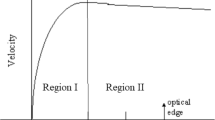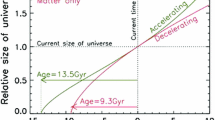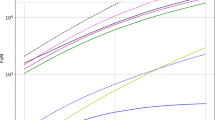Abstract
Typical cosmological models are based on the postulate that space is homogeneous. Space however contains overdense regions in which matter is concentrating, leaving underdense regions of almost void. The evolution of the scale factor of the universe has been established from measurements on SNIa. Since such events occur in regions were matter is present, we may expect that most of the SNIa are located in overdense regions. This means that the evolution of the scale factor has been established in a biased manner, by considering only information coming from overdense regions, excluding the one from the underdense regions. We develop a simple model to analyze the effect of this bias, and show that it leads to the appearance of a new tensor in the Einstein equation of general relativity, which can account for the apparent acceleration of the expansion of the universe. We further show that this tensor tends to be proportional to the FLRW metric tensor, and that the constant of proportionality quantitatively corresponds to the measured cosmological constant. We finally discuss the applicability of the bias to other probes used in determining the dynamics of the universe.
Similar content being viewed by others
Data Availability
Not applicable.
Code Availability
Not applicable.
References
Riess, A.G., et al.: (Supernova Search Team Collaboration): Observational evidence from supernovae for an accelerating universe and a cosmological constant. Astron. J. 116, 1009 (1998)
Perlmutter, S., et al.: (Supernova Cosmology Project Collaboration): Measurements of omega and lambda from 42 high-redshift supernovae. Astrophys. J. 517, 565 (1999)
Scolnic, D.M., et al.: The complete light-curve sample of spectroscopically confirmed SNe Ia from Pan-STARRS1 and cosmological constraints from the combined Pantheon Sample. Astrophys. J. 859, 101 (2018)
Buchert, T.: Dark energy from structure: a status report. Gen. Relativ. Gravit. 40, 467 (2008)
Kolb, E.W.: Backreaction of inhomogeneities can mimic dark energy. Class. Quant. Grav. 28, 164009 (2011)
Clifton, T.: Back-reaction in relativistic cosmology. Int. J. Mod. Phys. D 22, 1330004 (2013)
Célérier, M.-N.: Do we really see a cosmological constant in the supernovae data? Astron. Astrophys. D 353 (2000)
Iguchi, H., Nakamura, T., Nakao, K.: Is dark energy the only solution to the apparent acceleration of the present universe? Prog. Theor. Phys. 108, 809 (2002)
Alnes, H., Amarzguioui, M., Gron, O.: Inhomogeneous alternative to dark energy? Phys. Rev. D 73, 083519 (2006)
Ishak, M., Richardson, J., Whittington, D., Garred, D.: Dark energy or apparent acceleration due to a relativistic cosmological model more complex than FLRW? Phys. Rev. D 78, 123531 (2008)
Alexander, S., Biswas, T., Notari, A., Vaid, D.: Local void vs dark energy: confrontation with WMAP and type Ia Supernovae. J. Cosmol. Astropart. Phys. 9, 025 (2009)
Hunt, P., Sarkar, S.: Constraints on large-scale inhomogeneities from WMAP5 and SDSS: confrontation with recent observations. Mon. Not. R. Astron. Soc. 401, 547 (2010)
Farooq, O., Mania, D., Ratra, B.: Hubble parameter measurement constraints on dark energy. Astrophys. J. 764, 138 (2013)
Cautun, M., van de Weygaert, R., Jones, B.J.T., Frenk, C.S.: Evolution of the cosmic web. Mon. Not. R. Astron. Soc. 441, 2923 (2014)
Buchert, T., et al.: Is there proof that backreaction of inhomogeneities is irrelevant in cosmology? Class. Quant. Grav. 32, 21 (2015)
Tavasoli, S., Vasei, K., Mohayaee, R.: The challenge of large and empty voids in the SDSS DR7 redshift survey. Astron. Astrophys. 553, A15 (2013)
Falck, B., Neyrinck, M.C.: The persistent percolation of single-stream voids. Mon. Not. R. Astron. Soc. 450, 3239 (2015)
Bennet, C.L., et al.: Nine-year Wilkinson Microwave Anisotropy Probe (WMAP) observations: final maps and results. Astrophys. J. Suppl. Ser. 208, 20 (2013)
Aghanim, N., et al.: (Planck Collaboration): Planck 2018 results. VI. Cosmological parameters. Astron. Astrophys. 641, A6 (2020)
Jackson, N.: The hubble constant. Living Rev. Relativ. 18, 2 (2015)
Lewis, A., Challinor, A., Lasenby, A.: Efficient computation of cosmic microwave background anisotropies in closed Friedmann-Robertson-Walker models. Astrophys. J. 538, 473 (2000)
Riess, A.G.: The expansion of the universe is faster than expected. Nat. Rev. Phys. 2, 10 (2020)
Funding
No funding was received to assist with the preparation of this manuscript.
Author information
Authors and Affiliations
Corresponding author
Ethics declarations
Conflict of interest
The author has no relevant financial or non-financial interests to disclose.
Ethical Approval
Not applicable.
Consent to Participate
Not applicable.
Consent for Publication
Not applicable.
Additional information
Publisher's Note
Springer Nature remains neutral with regard to jurisdictional claims in published maps and institutional affiliations.
Rights and permissions
About this article
Cite this article
Deledicque, V. Dark Energy Explained by a Bias in the Measurements. Found Phys 52, 57 (2022). https://doi.org/10.1007/s10701-022-00575-9
Received:
Accepted:
Published:
DOI: https://doi.org/10.1007/s10701-022-00575-9




